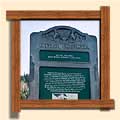|
![First ranchers in Elk Valley, British Columbia. [ca. 1905]](/2217/20101208160331im_/http://www.coalking.ca/images/glenbow/na-1320-4_thu.jpg) The Rocky Mountains are North America's largest mountain
system and comprise a significant portion of the border between
Alberta and British Columbia in the southern half of the two
provinces. At the time of Confederation in 1867, the mountains
were a barrier to Canadian unity and needed to be traversed to
unite all of Canada's regions and make the nation a reality. In
fact, one of the conditions of B.C. joining confederation was a
national railway needed to be built within ten years, or the
province would succeed. There are two significant mountain
passes and these comprise important railroad and highway routes:
the Kicking Horse Pass, to the south, and the Yellowhead Pass to
the north. Opening them to people and commerce is a significant
episode of bringing the west into Confederation. The Rocky Mountains are North America's largest mountain
system and comprise a significant portion of the border between
Alberta and British Columbia in the southern half of the two
provinces. At the time of Confederation in 1867, the mountains
were a barrier to Canadian unity and needed to be traversed to
unite all of Canada's regions and make the nation a reality. In
fact, one of the conditions of B.C. joining confederation was a
national railway needed to be built within ten years, or the
province would succeed. There are two significant mountain
passes and these comprise important railroad and highway routes:
the Kicking Horse Pass, to the south, and the Yellowhead Pass to
the north. Opening them to people and commerce is a significant
episode of bringing the west into Confederation.
The Rocky Mountains and foothill region is rich in coal deposits
as well as deposits of metals, such as tin, in the interior of
British Columbia. Thus, geology, the expansion of the railways,
the settlement of the West— all worked together to spur
immigration from various countries at the end of the 19th and
beginning of the 20th centuries. Immigrants began to come to
Canada at the end of the 19th century and the trickle became a
stream at the beginning of the 20th century. They came to work
in the building of the railroads and other construction, to work
in forestry camps and, then, moved into work in the mines and
urban areas. Read the exciting account of the heritage of the
Elk Valley region of the Rockies, including Fernie, Michel and
Natal and discover the personal stories of hard-working men and
women in the following sections of the When Coal was King
website. worked together to spur
immigration from various countries at the end of the 19th and
beginning of the 20th centuries. Immigrants began to come to
Canada at the end of the 19th century and the trickle became a
stream at the beginning of the 20th century. They came to work
in the building of the railroads and other construction, to work
in forestry camps and, then, moved into work in the mines and
urban areas. Read the exciting account of the heritage of the
Elk Valley region of the Rockies, including Fernie, Michel and
Natal and discover the personal stories of hard-working men and
women in the following sections of the When Coal was King
website.
 John Kinnear
Watch John Kinnear as he tells the story of coal mining in his
family's history, including its evolution over three
generations, in this video produced by CFCN Television.
|
 Heritage Community Foundation Presents
Heritage Community Foundation Presents




![First ranchers in Elk Valley, British Columbia. [ca. 1905]](/2217/20101208160331im_/http://www.coalking.ca/images/glenbow/na-1320-4_thu.jpg)

